Types of Operating System
There are various types of operating system:
- Simple Batch Operating System
- Multiprogramming batch Operating System
- Time-sharing Operating System
- Multiprocessor Operating System
- Distributed Operating System
- Network Operating System
- Real-time Operating System
- Mobile Operating System
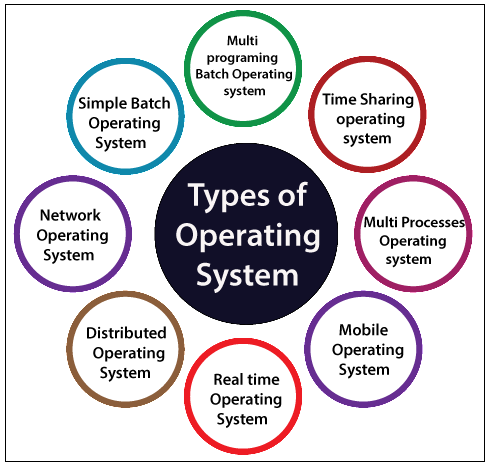
Simple Batch operating system
In the simple batch operating system, there is no direct communication between the user and the computer. In this, firstly, the user submits a job to the computer operator, and after submitting the job, the computer operator creates a batch of the jobs on an input device. The batch of jobs is created on the basis of the type of language and needs. After the batch of the job is created, then a special program monitors and manages each program in a batch. Example: Bank Statements, Payroll system, etc.
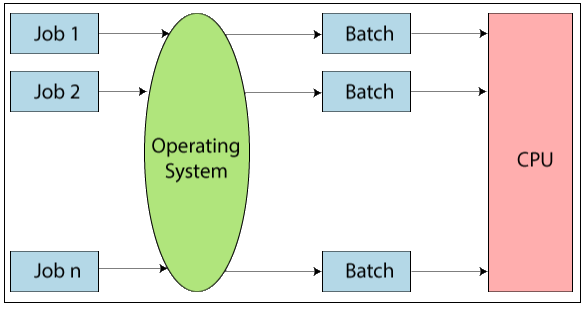
Advantages of Simple Batch Operating System
- There is no mechanism to prioritize the processes.
- There is no communication between the user and the computer.
- The ideal time is very less for a batch operating system.
Disadvantages of a Simple Batch Operating System
- It is hard to debug.
- The Batch operating systems are costly.
Multiprogramming Batch Operating System
In Multiprogramming Batch Operating System, the Operating system first selects the job, and after selecting the job, it begins to execute one of the jobs from memory. When this job requires an I/O operation operating system, it switches to another job (operating system and CPU always busy). In this, the jobs present in memory are always minimum than the jobs present in the job pool.
If different jobs are ready to execute at the same time, then the job is selected for CPU scheduling. In a simple batch operating system, sometimes CPU is idle and doesn’t perform any task, but in the multiprogramming batch operating system, CPU is busy and will never sit idle and always keeps on processing.
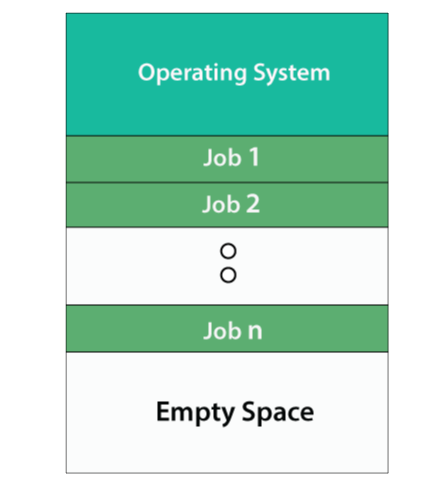
Time-Sharing Operating System
The Time-sharing systems are also called Multitasking systems. In Time-sharing operating system, we assign some time to each job so that all the jobs work efficiently and smoothly. The task may be from a single user as well as multiple users. The time taken by each job to execute the job is known as quantum. After the interval of time is over, the operating system moves to the next task. Time-sharing allows the various number of users to be placed at various terminals so that they can use a particular system at the same time. Time-sharing is sharing the processor’s time with multiple users simultaneously.
The major difference between Time-sharing operating system and Multiprogramming batch operating system is that the time-sharing operating system aims to minimize the response time, whereas the Multiprogramming batch operating system is to increase the use of the processor.
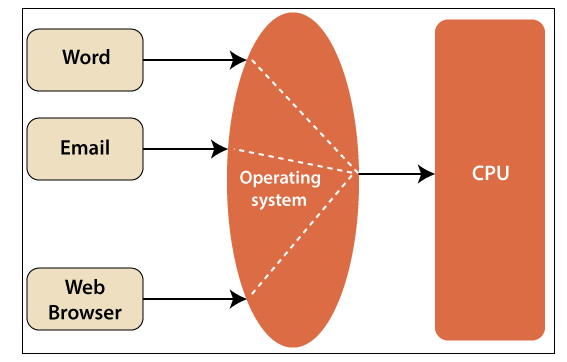
Advantages of Time-Sharing Operating System
- CPU remains idle for less time.
- No partiality occurs between the jobs.
- It quickly responses.
Disadvantages of Time-Sharing Operating System
- The Problem of Data commination.
- Not reliable
Multiprocessor Operating System
A Multiprocessor Operating System means the use of two or more processors within a single computer system. These multiple processors are in close communication and share the memory, computer bus, and other peripheral devices. These systems are known as tightly coupled systems. It offers high speed and computing power. In Multiprocessor operating system, all the processors work by using a single operating system.
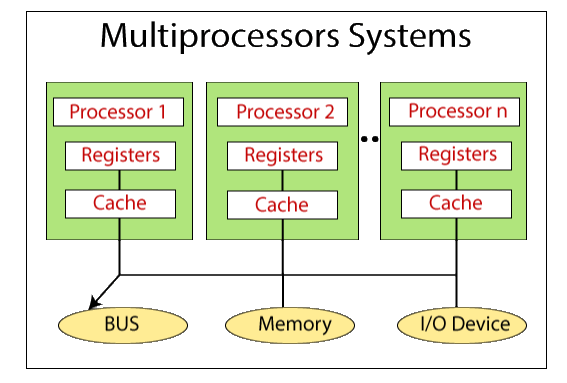
Advantages of Multiprocessor
- Improved performance.
- By maximizing the number of processors, more work is done in less time. In this way, throughput is increased.
- Increased reliability.
Distributed Operating System
Distributed systems are also known as loosely coupled systems. In this type of operating system, multiple central processors are used to serve multiple real-time applications and multiple users. In this, the jobs of data processing are shared in the processors accordingly.
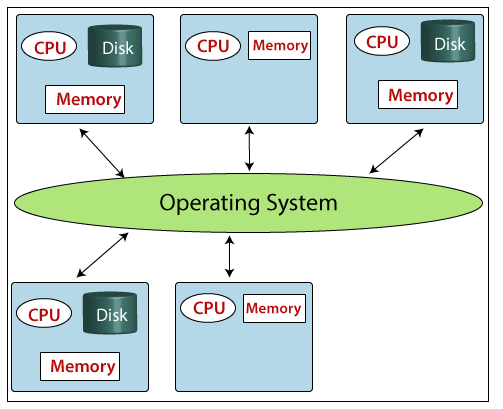
In this processor, interaction with each other takes place via communication lines like telephone lines, high-speed buses, etc. The processors can be different in function and size.
Types of Distributed Operating System
There are two types of Operating System:
- Client-server Systems.
- Peer-to-Peer system.
Advantages of Distributed Operating System
The advantages of a distributed system are:
- Speed is increased by the exchange of information with the help of electronic mail.
- It offers better services to customers.
- Reduce delays in the processing of data.
- By resource sharing ability, a user at one site can access the resources that are available at another site.
- It offers reliability. If, in any case, one site fails then, the rest of the other sites work properly.
- Reduces load on the host computer.
Disadvantages of Distributed Operating System
- Distributed systems are more expensive.
- Failure of the central network stops the whole communication.
Network Operating System
The network operating systems are also called tightly coupled systems. A network operating system is a type of operating system which is created to help personal computer, workstations. Network operating systems are operated on a server and offer the facility of security, users, applications, data management, and other networking related functions. Its objective is to permit file sharing and printer access among various computers in a network, i.e., local area network (LAN), Private network, etc.
Example of Operating System: Unix, Linux, Novell NetWare, BSD, Microsoft Windows Server 2008.
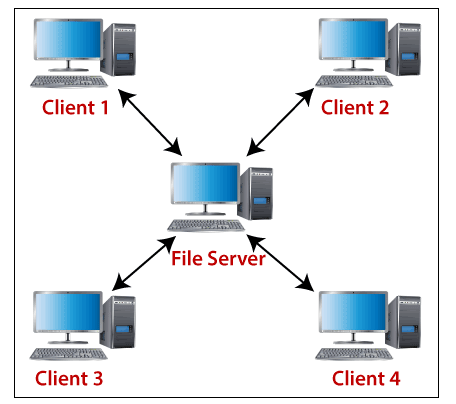
Advantages of Networking Operating System
- Provide the facility of remote access to servers from different locations.
- Allows easy upgradation of new technologies.
- Improves scalability.
- Security is managed via the servers.
Disadvantages of Networking Operating System
- Needed regular updates and maintenance.
- It is expensive.
- Many operations depend on a central location.
Real-Time Operating System
Real-time operating systems are the operating systems that are used in real-time applications where the data processing must be done in a fixed interval of time. The Real-time operating system gives the response very fast and quick. The Real-time operating system is used when a large number of events are processed in a short interval of time.
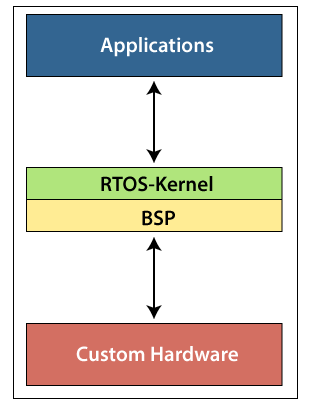
A real-time operating system is different from another operating system because, in this, time concept is the most crucial part. It is based on clock interrupts. In the real-time system, the process is executed on the basis of priority. The high priority process always executes first. When a high priority process enters into the system, the low priority process preempts to serve a high priority process. The task of synchronizing the process is done by the real-time operating system so that the process can interact with each other efficiently. In this way, resources are used effectively without time-wasting. Example of the real-time operating system: Medical imaging systems, Industrial system, Nuclear reactors control scientific experiments, Traffic controlling signal, Military software system, Airline resolution system, Networked multimedia systems, Internet telephony, etc.
Types of Real-Time Operating System
There are three types of Real-time operating system:
- Hard Real-time
- Soft Real-time
- Firm Real-time
Hard-Real time: - In Hard-Real time system, there is some deadline for executing the task, which means that the task must start its execution on the particular scheduled time, and should complete within the assigned duration of time.
Example: - Aircraft systems, Medical critical care System, etc.
Soft-Real time: - In the Soft-Real time system also, we assign a time to each process, but some delaying in time is acceptable. So, in Soft-real time, deadlines are handled softly. That’s why it is called Soft-Real time. Example: - Live stock price and Online Transaction System.
Firm-Real time: - In the Firm-Real time system, there is also a deadline for every task to execute. But in this, due to missing deadlines, there may be no big impact, but there can be chances of undesired effects such as problems in the quality of a product.
Example: - Multimedia Applications.
Advantages of Real-Time Operating System
- Real-time operating systems are error-free.
- Real-time operating systems offer the facility of memory allocation management.
- It offers better utilization of devices and systems and produces more output from all the resources.
- The real-time operating system more focuses on running the applications and give less importance to those applications which are present in the queue.
Disadvantages of a Real-Time Operating System
- In Real-Time Operating System, the task of writing the algorithm is very challenging and complex.
- Real-Time Operating System is expensive because it is using heavy system resources.
Mobile Operating System
Mobile Operating System is the type of operating system which is mainly designed to power smartphones, wearables devices, and tablets. Example: - Android, BlackBerry, WatchOS.